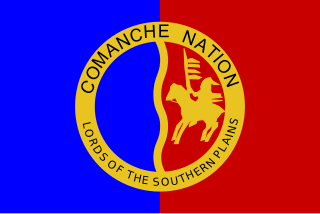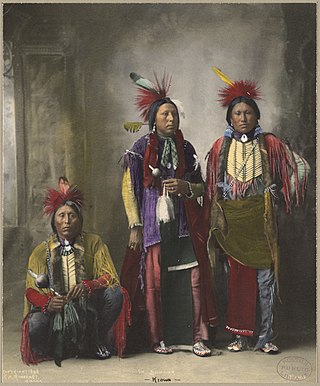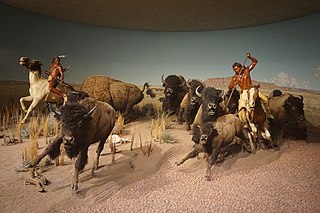
The Crow, whose autonym is Apsáalooke, also spelled Absaroka, are Native Americans living primarily in southern Montana. Today, the Crow people have a federally recognized tribe, the Crow Tribe of Montana, with an Indian reservation, the Crow Indian Reservation, located in the south-central part of the state.

The Comanche or Nʉmʉnʉʉ is a Native American tribe from the Southern Plains of the present-day United States. Comanche people today belong to the federally recognized Comanche Nation, headquartered in Lawton, Oklahoma.

Crow Agency is a census-designated place (CDP) in Big Horn County, Montana, United States and is near the actual location for the Little Bighorn National Monument and re-enactment produced by the Real Bird family known as Battle of the Little Bighorn Reenactment. The population was 1,616 at the 2010 census. It is the governmental headquarters of the Crow Native Americans. It is also the location of the "agency offices" where the federal Superintendent of the Crow Indian Reservation and his staff interacts with the Crow Tribe, pursuant to federal treaties and statutes.

The Blackfoot Confederacy, Niitsitapi, or Siksikaitsitapi, is a historic collective name for linguistically related groups that make up the Blackfoot or Blackfeet people: the Siksika ("Blackfoot"), the Kainai or Blood, and two sections of the Peigan or Piikani – the Northern Piikani (Aapátohsipikáni) and the Southern Piikani. Broader definitions include groups such as the Tsúùtínà (Sarcee) and A'aninin who spoke quite different languages but allied with or joined the Blackfoot Confederacy.

A tipi or tepee is a conical lodge tent that is distinguished from other conical tents by the smoke flaps at the top of the structure, and historically made of animal hides or pelts or, in more recent generations, of canvas stretched on a framework of wooden poles. The loanword came into English usage from the Dakota language and Lakota language.

Kiowa or CáuigúIPA:[kɔ́j-gʷú]) people are a Native American tribe and an Indigenous people of the Great Plains of the United States. They migrated southward from western Montana into the Rocky Mountains in Colorado in the 17th and 18th centuries, and eventually into the Southern Plains by the early 19th century. In 1867, the Kiowa were moved to a reservation in southwestern Oklahoma.

Plains Indians or Indigenous peoples of the Great Plains and Canadian Prairies are the Native American tribes and First Nation band governments who have historically lived on the Interior Plains of North America. While hunting-farming cultures have lived on the Great Plains for centuries prior to European contact, the region is known for the horse cultures that flourished from the 17th century through the late 19th century. Their historic nomadism and armed resistance to domination by the government and military forces of Canada and the United States have made the Plains Indian culture groups an archetype in literature and art for Native Americans everywhere.

Peter Rindisbacher was a Swiss artist. He specialized in watercolors and illustrations dealing with First Nation tribes of mid-Western Canada and the United States, mostly depictions of the Anishinaabe, Cree, and Sioux, usually in group action or genre scenes. He seldom did individual portraits; however, he painted himself into a few interior tipi scenes, usually smoking a pipe. He commonly referred to the tipis as tents, such as in the title, Inside a Skin Tent.
Native Americans have been featured in numerous works of children's literature. Some have been authored by non-Indigenous writers, while others have been written or contributed to by Indigenous authors.

Paul Goble was a British-American writer and illustrator of children's books, especially Native American stories. His book The Girl Who Loved Wild Horses won a Caldecott Medal in 1979.
Elaine Marie Alphin was an American author of more than thirty books for children and young adults.

The Girl Who Loved Wild Horses, written and illustrated by Paul Goble, is a children's picture book originally released by Bradbury Press in 1978. It was the recipient of the Caldecott Medal for illustration in 1979. As of 1993, the book has been published by Simon & Schuster.

Founded in 1984, the Midwest Independent Publishers Association, or MIPA, is a nonprofit organization based in Minneapolis, Minnesota and serving 12 states. The association serves the Upper Midwest small press community through education, Business networking, and Community recognition. MIPA's members include printers, distributors, editors, indexing professionals, artists, and designers. MIPA is a regional affiliate of the Independent Book Publishers Association (IBPA).
World Wisdom is an independent American publishing company established in 1980 in Bloomington, Indiana. World Wisdom publishes religious and philosophical texts, including the work of authors such as Frithjof Schuon, Seyyed Hossein Nasr, Titus Burckhardt, Ananda K. Coomaraswamy, Joseph Epes Brown, Charles Eastman, Paul Goble, Swami Ramdas, Samdhong Rinpoche, William Stoddart, and Martin Lings.
Roland Smith is an American author of young adult fiction as well as nonfiction books for children.
Tipi is a dwelling used by North American Indians of the Great Plains.

Bison hunting was an activity fundamental to the economy and society of the Plains Indians peoples who inhabited the vast grasslands on the Interior Plains of North America, before the animal's near-extinction in the late 19th century following US expansion into the West. Bison hunting was an important spiritual practice and source of material for these groups, especially after the European introduction of the horse in the 16th through 19th centuries enabled new hunting techniques. The species' dramatic decline was the result of habitat loss due to the expansion of ranching and farming in western North America, industrial-scale hunting practiced by non-Indigenous hunters increased Indigenous hunting pressure due to non-Indigenous demand for bison hides and meat, and cases of a deliberate policy by settler governments to destroy the food source of the Indigenous peoples during times of conflict.

Plains hide painting is a traditional North American Plains Indian artistic practice of painting on either tanned or raw animal hides. Tipis, tipi liners, shields, parfleches, robes, clothing, drums, and winter counts could all be painted.

Emily Jenkins, who sometimes uses the pen name E. Lockhart, is an American writer of children's picture books, young-adult novels, and adult fiction. She is known best for the Ruby Oliver quartet, The Disreputable History of Frankie Landau-Banks, and We Were Liars.

The following outline is provided as an overview of and topical guide to the prehistoric people of Colorado, which covers the period of when Native Americans lived in Colorado prior to contact with the Domínguez–Escalante expedition in 1776. People's lifestyles included nomadic hunter-gathering, semi-permanent village dwelling, and residing in pueblos.














